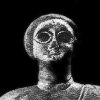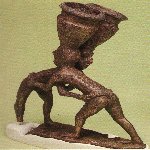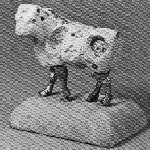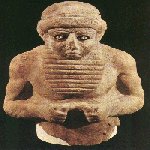





 |
 |
 |
 |
 |
 |
 |
We now know the Sumerians first appeared about 4800 B.C. at a place called Al-Ubaid. During the next few centuries they established other cities primarily along the southern half of the Mesopotamian river system.
They were not indigenous: from where they originated is debated by scholars. What is known is that they were a tremendously gifted and imaginative people. Their language, linguistically related to no other, ancient or modern, is preserved for us through the thousands of clay tablets on which they inscribed and developed the first writing as yet known to man.
Fortunately, the Sumerians were prolific writers and meticulous record- keepers: these tablets richly describe their existence. With the invention of writing the simple village life could evolve into complex civilization.
They developed schools for an educated elite and for the many scribes who were needed for all the record-keeping and letter-writing they liked to do. Not only business records were written down but also the first numbers, calendars, literature, laws, agricultural methods, pharmacopoeias, personal notes, maps, jokes, curses, religious practices, and thousands of lists and inventories of all manner of human interests.
 |
These cuneiform tablets show the Sumerians established great city states at Ur and elsewhere, absorbing the indigenous peoples and extending their influence beyond Mesopotamia to the Mediterranean Coast, the Arabian Peninsula, to Egypt, and India.
Theirs was an urban civilization in which architects were familiar with all the basic architectural principles known to us today, the artist possessed the highest skills and standards of excellence, and the metal worker had a knowledge of metallurgy and technical skill which few ancient people ever rivaled. The merchant carried on a far-flung trade facilitated by the development of the wheel and axle and the sail-driven boat. The armed forces were well organized and victorious. Agriculture was productive and prosperous. Indeed, the great wealth accumulated by their civilization enabled the Sumerians to live in relative luxury for some 2000 years or more.
The various city states which comprised the Sumerian civilization continued to rise and fall in influence during these two millennia. Ur, Lagash, Kish, Eridu, Lar Sa, Babylon, Uruk, and others - each ruled by a king‹were in constant conflict, and their dominion over each other and over surrounding peoples shifted as often as the course of the rivers along side which their cities were built.
Before Men came, Mesopotamia was a lifeless awirl of air, water and mist. At least, that is what legend says, and we do not know any better. Up to the thrid millennium B.C., the history of Ancient Iraq is elusive. Did civilised Man appear there six thousand years ago, or seven thousand? That far back in time, even the experts allow themselves a few centuries of doubt this way or that.
Human civilization was born with Sumerians who, at the beginning of the fifth millenium B.C., started building the first cities in the alluvial plains of Mesopotamia, in what is now modern Iraq. Their way of life gave birth to a social organisation whose consequence was a mature form of art.
These two statuettes confirm this maturity: the first one, a women with child, was found in the excavation of Ur, and the second one in the excavation of Uruk. They both date back to the fourth millenium B.C. Together with Eridu, Ur and Uruk were the principal Sumerian cities. The Bible also reminds us of them: Ur in particular because it was Abraham's native land.
 |
 |